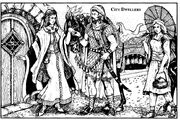
The Sîranians or Sîrani were the native Haradrim of Greater harad or Sîrayn.In contrast to the people of Bellakar, Bôzisha-Mîraz, Harûzan and the Utter south the Sîranians were more closely related to the eastern Haradrim of Khyan.
The Sîrani divided themselves into the urban Sîranians, the Cénnacatti,Haráni, Póa, Tyari, the notorious Másra and Bulgan clans as well as the rural River-Valley People, including the Bausairin.The desert-dwelling Ayten-Nomads were regarded as outsiders and not true Sîrani.
They spoke Tazinain, which was an admixture of the ancient Apysaic language and the Talataerim dialect spoken by the ancient Khailûzans. It is distant from most Haradaic languages, though common words from other parts of Harad are often recognizable.
Political and social structure[]
Ultimate power is held by a Tarb ("Might-lord"). Under a Tarb there is a Balabett ("Governor") who administers small regions, while a Balazain functions as the mayor of a town or city. The Tarb relies on these men and his council while making decisions for his domain, called a Mezin-tarb.
The buying and selling of slaves is an accepted practice in many cities. The first slaves in the early cities of the region were war captives, and the ransom of prisoners evolved into the slave trade. Slavers comb the city to kidnap easy targets such as lone foreigners or stray children. Debtors are also commonly sold into slavery. Slaves are traded between cities, and also to foreign realms, such as Gan to the south.
Not all in Sîrayn support slavery. The Ayten, believers in the Tayê faith, and the Danak actively oppose the slave trade and often attack slavers and liberate the enslaved people.
Worship[]
The traditional religion and most common faith of the people is the Tayê faith. Devotees follow the Gabbaz ("Holy Order") who interpret the writings of the Tarat, ("Holy Writings"). They contain religious knowledge accumulated over the centuries. Their chief diety is Tarkarûn-i-Mâsra, identified as Manwë by many. They also worship many lesser gods. Followers of the Tayê are considered the true Free Peoples of the region.
There are also some cults in the region, such as the temples to Saubaiz, the spider-god of thieves and the second most popular religion in the region.
Other faiths include the Keepers of the True Flame and the Followers of the Silent One, the nemesis of the Free Peoples and followers of the Shadow.
City dwellers consider themselves henotheistic, and each city has its own local lesser god.
References[]
- MERP:Greater Harad
